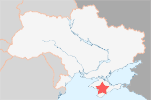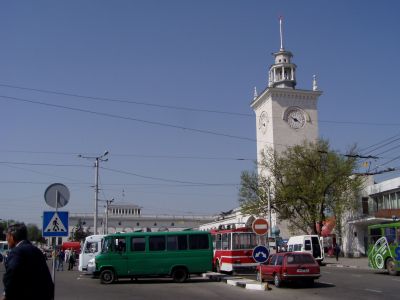Name

| ||
| Simferopol |
Симферополь (Simferopol) - this is the Russian (and still most common) spelling - the Ukrainian spelling is only slightly different: Сімферополь. The Crimean Tatar name for the town is Aqmescit, which means "White Mosque". The name derives from the old Greek name Sympheropolis, which means "the city of usefulness" (with -pol as the distinctive Greek ending for towns, meaning "town").
Location
Simferopol stretches along the northern foot of the Crimea mountains and marks the centre of the Crimean peninsula. The town itself is rather flat. The small river Salhir crosses the town.
Population
Simferopol has more than 350,000 inhabitants - making it the largest town of the Crimea. Therefore it's the capital of the Autonomous Republic Crimea, dominated by ethnic Russians. And so the Crimea and Simferopol is much more Russian than the rest of the country.
History
The city itself was founded by empress Catherine the Great (also: the II.) in the year 1784. Who else... It was only one year before that the Russian empire managed to annex the peninsula. However, Simferopol stands on historically important ground. At the same place, a town called Neapolis was founded in the 4th century B.C. and became the capital of the Scythian Crimea, at that time called Tauris.
Getting there / transportation
Unless coming from the sea, almost everyone heading for Yalta and the southern coast stops at Simferopol first, since the town has the most important train station of the peninsula and the international airport nearby. However, no one walks around Simferopol. The city itself is quite spacious and has lots of parks. Unfortunately there aren't any highlights, so don't expect a small version of Odessa or something. All trains coming from Russia and the Ukraine terminate in Simferopol. From there, you can easily go to other places on the peninsula, like Kerch, Sevastopol, Bachtchisaray and →Yalta etc.

| ||
| Main train station of Simferopol |
Simferopol as a gateway to the Crimean peninsula and has therefore excellent long-distance train connections: To St. Petersburg, Moscow (24 hrs), →Minsk (31 hrs), Kaliningrad (44 hrs), Sverdlovsk (45 hrs) and national connections to →L'viv (24 hrs), →Dnepropetrovsk (7½ hrs for 500km, € 5 for a seat in a compartment), →Kyiv (Kiev) (15 hrs), →Odesa (13 hrs, € 4 for Plazkartnyi) etc. For getting to Yalta, see information on →Yalta
Simferopol is a wide town with beautiful parks, but there are no distinctive sights that are particularly interesting to the visitors - therefore, almost everyone stays for a couple of hours only in Simferopol - until the lift to the next place leaves. The train station itself is worth to have a closer look at.
Крым (Krim - Crimea)
The Krym (Crimea) peninsula projects into the Black Sea like a large hammer, only to be connected with the rest of the country by a narrow, 10 km wide isthmus in the north-west and and a long bridge in the north-east. Especially in the north, many islets and lakes cover the land. From the north to the south it's more than 200 km, from the east to the west it's around 350 km at most. The whole peninsula is 26,000 km² big - only slightly smaller than Belgium. Except for the southern coast, the land is as flat as a pancake and covered by steppe and salt marshes. This is best to be seen between Dshankoy in the north and Simferopol. Along the southern coastline between Feodossiya and Sevastopol, the Crimean mountains towers the Black Sea. The highest peak is the 1,545 m high Roman-Kosh. There are also several cañon-like valleys between the mountains. Thanks to the mountain range, the southern coast is protected against cold wind from the north and therefore almost subtropical. This allows winegrowing and the production of the famous Crimean champagne.

| ||
| Flat as a pancake: water and land in the north |
Numerous tribes and nations left their traces on the peninsula. Probably the first was the Tauri tribe of the Cimmerian people, next the Scythians, to be followed by ancient Greeks. At that time, the Crimea was known as the "Tauris" peninsula. After the Greeks, the Genovans came. Mongols of the Golden Horde, Turks and eventually the Russians settled in the area. The present-day name "Krym (Crimea)" probably derives from the Mongolian word for "rock" and refers to the southern part of the peninsula. Tatar tribes managed to remove the Mongolians and founded their own Khanate. The small city of Bachtchisaray became the capital, with the Khanate's residence still existing today. The Krym-Tatars grew very strong and even exacted tribute from the Russian tsars. They even raided Moscow in the 16th century when the Tsar refused to pay. Due to the Crimean war in 1853, many Tatars left the peninsula. In world war II, the German army besieged the peninsula for 8 long months before they managed to invade. After the end of the war, Stalin expelled many minorities and didn't spare the rym-Tatars. They were accused of collaborating with Nazi-Germany and brutally expelled with most of them ending up somewhere in Siberia.
Today, more and more Krym-Tatars are returning to their homeland. The Crimea has around 2.3 million inhabitants, around 70% of them Russians. The biggest minority of course are the Ukrainians, but there are also Armenian, Greek and above-mentioned Krym-Tatar minorities. The fact that the Crimea has been influenced by many nations, is still visible today. And so it comes as no surprise to see even minarets here and there.
We decided to move on to Yalta, so I can't recommend any place to stay in Simferopol personally - since most visitors move on as well, selection is probably limited to that of a typical smaller town.
- www.simferopol-rada.gov.ua/ Official website of Simferopol - badly laid-out and in Ukrainian only (as of 2008). Apparently, it's not easy to find information in English on Simferopol.
Do you have or do you know a good website about Simferopol? Don't hesitate, let me know! After checking it, I would love to add it to the link list. You can submit a link by using the →contact form. Note that commercial websites will be treated differently.
©2024 Europe-East.com

 Albania
Albania Ukraine
Ukraine